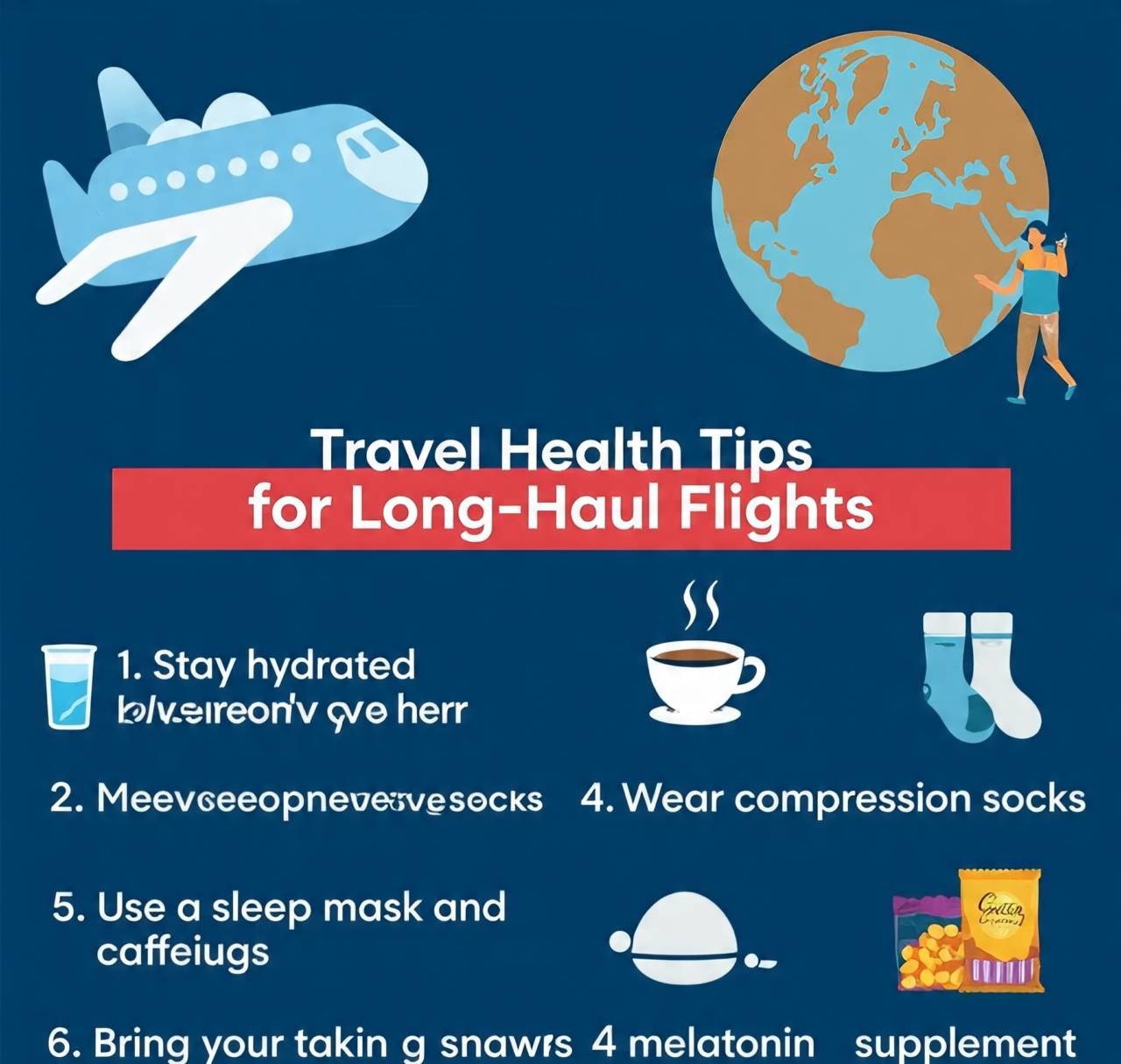Key Takeaways:
- Stay hydrated by drinking water regularly throughout the flight.
- Engage in in-seat exercises and periodic movement to promote circulation.
- Choose comfortable attire and consider using compression socks.
- Maintain a balanced diet and avoid excessive caffeine and alcohol.
- Prepare for sleep by bringing necessary accessories and adjusting to time zones.
Table of Contents:
- Hydration Strategies
- In-Flight Exercises
- Comfortable Attire
- Nutrition and Diet
- Sleep Preparation
- Managing Jet Lag
- Additional Health Considerations
Long-haul flights can be challenging due to discomfort, dehydration, and physical strain. Embracing proactive health strategies can improve well-being and enhance journey and destination time. Prioritizing comfort is crucial, and wearing compression socks for flying can reduce swelling, boost circulation, and lower the risk of deep vein thrombosis. Long-haul travel doesn’t have to be distressing or fatigue-prone. By hydration, regular movement, making healthy choices, and preparing for in-flight rest, travelers can transform long-haul flights into enjoyable experiences. Pre-flight planning and travel-friendly accessories can ensure readiness and comfort.
Hydration Strategies
Airplane cabins are often drier than expected, with humidity below 20%. This can cause dehydration, headaches, dizziness, dry skin, fatigue, and irritability. To combat this, drink at least eight ounces of water every hour, carry a reusable bottle, and avoid diuretic beverages like coffee, tea, and alcohol. Apply high-quality moisturizer and lip balm before boarding to create a barrier against moisture loss. Staying hydrated supports the immune system, reduces travel’s impact on the body, and lessens jet lag upon arrival.
In-Flight Exercises
Extended periods of immobility are among the biggest risks on long-haul flights, particularly regarding blood circulation and muscle stiffness. Sitting for hours can slow blood flow in your legs, which increases susceptibility to DVT and swelling. Incorporate simple yet effective movements every 30 to 60 minutes to counteract this. For example, ankle circles involve lifting your feet slightly and rotating your ankles, promoting blood flow and preventing stiffness. Seated leg lifts involve slowly extending your legs, holding for a few seconds, and lowering again; this movement helps engage muscles and keeps blood from pooling. Shoulder rolls alleviate upper-body tension, especially when confined to narrow seats. Walking breaks in the aisle offer full-body movement and a mental refresh whenever the seatbelt sign is off. When done consistently, even these micro-exercises can dramatically reduce the risk of in-flight circulatory issues, while ensuring you arrive feeling far less sore and more mobile.
Comfortable Attire
During long-haul travel, it’s crucial to choose comfortable and breathable clothing. Choose loose-fitting fabrics like cotton or moisture-wicking blends for temperature regulation. Layer outfits with light sweaters or jackets for quick adjustments. Compression socks are a health-conscious addition, stimulating blood circulation in the lower extremities and reducing the risk of DVT. Choose shoes that slip on easily and provide adequate arch support for walking or standing stretches. Prioritizing comfort and flexibility enhances the journey and health throughout the flight.

Nutrition and Diet
In-flight dining offers limited choices, but food choices are crucial for comfort, digestion, and energy levels. Choose light, nutrient-dense options like salads, grilled chicken, yogurt, or fresh fruit for easy digestion. Pack healthy snacks like nuts, dried fruit, or granola bars for control over nutrients. Avoid high-sugar, high-salt foods and excessive caffeine or alcoholic beverages to avoid fatigue. Consistently making balanced meals and snacks supports the immune system, promotes a stable mood, and minimizes digestive issues, helping to cope with long-haul air travel.
Sleep Preparation
Getting quality rest during a flight is crucial for a refreshed and prepared experience. Bring essential items like a neck pillow, eye mask, and noise-canceling headphones to improve sleep. Adjust your sleeping schedule to match your destination’s time zone and avoid bright screens for at least 30 minutes before sleeping. A relaxation routine can help mitigate jet lag and facilitate a smooth transition from the plane to new surroundings.
Managing Jet Lag
Crossing multiple time zones disrupts the body’s circadian rhythm, resulting in symptoms like insomnia, grogginess, irritability, and confusion—collectively known as jet lag. Combatting jet lag effectively starts before your flight. Adjust your bedtime and meal times closer to your destination’s schedule several days before boarding. Once onboard, try to sleep or stay awake in alignment with your new time zone. Immediately upon arrival, expose yourself to natural sunlight as much as possible—light is a powerful regulator of your internal clock and speeds recovery time. Continue to hydrate and avoid heavy, sugary foods, as these can extend recovery. Strategic management of sleep and light exposure balances your body’s rhythms and minimizes the mental and physical toll of adjusting to a new environment.
Additional Health Considerations
Anyone managing chronic health conditions or taking prescription medication should take extra precautions before and during flights. Always consult your healthcare provider before travel, especially if you have cardiovascular, respiratory, or mobility issues, to discuss necessary precautions and obtain appropriate documentation. Keep all essential medications in your carry-on baggage (never checked), and pack more than enough to cover your entire trip, accounting for possible delays. Recognize that drastic cabin pressure changes can worsen certain conditions, so bring backup inhalers, EpiPens, or other emergency provisions as needed.





